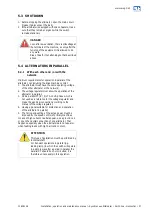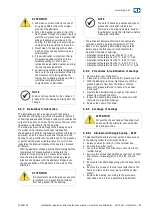
12638144 Installation, operation and maintenance manual – Synchronous Alternator – AG10 line - Horizontal l 25
Figure 4.6:
Coefficient of variation of insulation resistance with
temperature
The values used to generate the curve of Figure 4.6 are
shown in Table 4.4.
Table 4.4: Insulation resistance correction factor in with the
temperature
t (ºC)
Kt factor
10
0,7
20
0,8
30
0,9
40
1,0
50
1,5
60
2,3
70
3,3
80
4,6
4.6
PROTECTION
4.6.1
Thermal protection
Alternators have, when requested, protective devices
against excessive rise in temperature, installed in the
stator coils, and / or bearings, as follows:
Thermostat (bimetal):
bimetallic thermal detectors, with
normally closed silver contacts that open when they reach
the temperature of operation. Thermostats can be
connected in series or independently according to wiring
diagram.
Thermistors (PTC or NTC type):
Heat detectors,
semiconductor compounds that vary their resistance
sharply to reach the temperature of operation. Thermistors
can be connected in series or independently according to
wiring diagram.
NOTE
Thermostats and thermistors must be
connected to a control unit that stops
operation of the alternator or triggers a
signaling device.
Thermistor (RTD)
- A calibrated resistance element. Its
operation is based on the principle that the electrical
resistance of a metallic conductor varies linearly with
temperature. The terminals of the detector must be
connected to a control panel, which includes a
temperature gauge.
NOTE
The thermistors type RTD allow monitoring of
the absolute temperature. With this
information, the relay can do the temperature
reading, as well as the parameterization for
alarm and shutdown according to the preset
temperatures.
The following formula is used to convert the value of the
ohmic resistance of the temperature measurement for
thermistors Type Pt 100.
Where:
= ohmic resistance measured on the PT-100
The protective devices, when requested, are listed in the
wiring diagram specific to each alternator. The non-use of
these devices is the sole responsibility of the user, but
may result in loss of guarantee in case of damage.
4.6.1.1
Temperature limits for the windings
The temperature of the hottest point of the winding must
be kept below the limit of thermal class of insulation. The
total temperature is composed of the sum of temperature
with the rise of temperature (
T), plus the difference
between the average temperature of the winding and the
hottest point of the winding. The ambient temperature is
typically up to 40 °C. Above this value, the working
conditions are considered special.
Table 4.5 shows the numerical values and composition of
the permitted temperature of the hottest point of the
winding.
Table 4.5: Insulation class
Insulation class
F
H
Ambient temperature
°C
40
40
T = temperature rise (resistance method)
°C 105 125
Difference between the hottest point and the
average temperature
°C
10
15
Total: Temperature of the hottest point
°C 155 180
ATTENTION
If the alternator works with winding
temperatures above the limits of thermal
class, the life of the insulation and hence of
the alternator is reduced substantially, or even
may cause burning of the alternator.
4.6.1.2
Thermal protection for the bearings
The temperature sensors installed on the bearings (if any)
are used to protect them from damage due to operation
with overheating.
Formula:
- 100 =
C
0,386






























